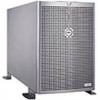Dell PowerEdge 6800 Installation and Troubleshooting Guide (.htm) - Page 5
Safety Instructions - server
 |
View all Dell PowerEdge 6800 manuals
Add to My Manuals
Save this manual to your list of manuals |
Page 5 highlights
Safety Instructions Use the following safety guidelines to ensure your own personal safety and to help protect your server, storage system, or appliance from potential damage. For complete safety and regulatory information, see your Product Information Guide. Warranty information might be included within this document or as a separate document. Precautions for Rack-Mountable Products Observe the following precautions for rack stability and safety. Also refer to the rack installation documentation accompanying the system and the rack for specific warning and/or caution statements and procedures. Servers, storage systems, and appliances are considered to be components in a rack. Thus, "component" refers to any server, storage system, or appliance, as well as to various peripherals or supporting hardware. CAUTION: Before installing systems in a rack, install front and side stabilizers on stand-alone (single) racks or the front stabilizer on racks joined to other racks. Failure to install stabilizers accordingly before installing systems in a rack could cause the rack to tip over, potentially resulting in bodily injury under certain circumstances. Therefore, always install the stabilizer(s) before installing components in the rack. CAUTION: After installing system components in a rack, never pull more than one component out of the rack on its slide assemblies at one time. The weight of more than one extended component could cause the rack to tip over and injure someone. NOTE: Your system is safety-certified as a free-standing unit and as a component for use in a rack cabinet using the customer rack kit when both the rack cabinet and rack kit were designed for your system. The installation of your system and rack kit in any other rack cabinet has not been approved by any safety agencies. It is your responsibility to have the final combination of system and rack kit in a cabinet evaluated for suitability by a certified safety agency. The manufacturer disclaims all warranties and liability in connection with such combinations. • System rack kits are intended to be installed in an approved rack by trained service technicians. If you install the kit in any other rack, be sure that the rack meets the specifications. CAUTION: Do not move large racks by yourself. Due to the height and weight of the rack, it is recommended that a minimum of two people perform this task. • Before working on the rack, make sure that the stabilizers are secured to the rack, extend to the floor, and that the full weight of the rack rests on the floor. Install front and side stabilizers on a single rack or front stabilizers for joined multiple racks before working on the rack. • Always load the rack from the bottom up, and load the heaviest item in the rack first. • Make sure that the rack is level and stable before extending a component from the rack. • Use caution when pressing the component rail release latches and sliding a component into or out of a rack; the slide rails can pinch your fingers. Tower-to-Rack Conversion Guide 5














